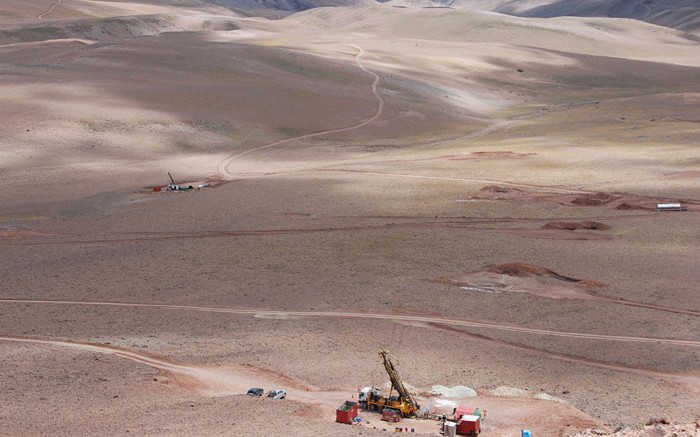Exeter Resource (TSX: XRC) is considering building a smaller-scale operation at its Caspiche gold-copper project in Chile’s famed Maricunga gold belt to lower start-up costs compared to developing a super pit that was proposed in its January 2012 prefeasibility study.
The goal of the ongoing work is to find a development scenario for Caspiche that provides flexibility and better fits the economic conditions than the previous capital-intensive operation, Exeter says. The prefeasibility study envisioned Caspiche as an open-pit mine producing 150,000 tonnes per day of sulphide ore, in addition to 72,000 tonnes per day of heap leachable oxide ore. The large scale operation was estimated to produce 696,000 oz. gold, 244 million lb. copper and 844,000 oz. silver each year over a 19-year life. Costs to get the super pit up and running were US$4.6 billion.
But to make the initial capital requirements more manageable, the Vancouver-based explorer is evaluating a standalone open-pit oxide gold operation, which may be expanded underground by mining the central, higher-grade gold-copper sulphide deposit.
The junior is looking at reducing the throughput of the open pit to 30,000 tonnes per day. At this rate, Caspiche should produce 100,000 oz. gold a year and have a 10-year mine life.
For the underground portion, Exeter intends to extract the higher grade ore using open stope mining, rather than the block cave technique that it previously evaluated. It is targeting to extract 15,000 tonnes per day from the underground before potentially expanding throughput to 27,000 daily tonnes.
Along with bringing down capital expenditures, the company says, water requirements should be significantly reduced with the new scenarios. It expects water requirements of 50 litres per second for the standalone oxide operation and 250 litres per second for the underground sulphide development, compared to the estimated 1,000 litres per second for the original operation.
Exeter intends to provide an update on its ongoing water exploration by year-end. It is slated to release a schedule for its formal economic studies in early 2014.
“Given the company’s size and limited financial resources, BMO Research currently incorporates only the smaller-scale oxide scenario in its DCF (discounted cash flow) model,” BMO Nesbitt Burns analyst John Hayes writes, adding Exeter had $45.3 million in working capital in June 2013.
Hayes remains cautious on the company’s underground plans at Caspiche, noting he’s still waiting to see how a “new design would improve overall economics, and if it provides any further options for dealing with arsenic-bearing sulphide mineralization that increase project complexity.” He has a “speculative underperform” rating on the stock.
Salman Partners analyst David West appears more optimistic about Exeter’s new open pit and underground strategy for the Caspiche project. West has a $2.35 target price and a “speculative buy” on the stock.


Be the first to comment on "Exeter downsizes Caspiche to cut costs"